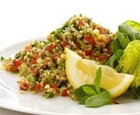|
Mid-East Side Bulgur Wheat Salad A delectible combination of nutty bulgar wheat with mint, tomatoes, scallions, and a tangy dressing of oil and lemon.
In a large bowl, pour boiling water over bulgur, cover well, and let stand 2-3 hours until wheat has absorbed most, if not all, of the water. Drain any excess and make sure wheat is dry and fluffy.* Combine with remaining ingredients and mix thoroughly. Chill before serving. *This is the hardest part of the recipe. Try placing bulgur on a linen towel, then roll and press to thoroughly dry the wheat. It's messy, but it works. |
Tips & Glossary Many of the ingredients used for Middle-Eastern cooking may not be in your spice shelf, but you can find them at Mid-Eastern food stores. So to avoid frustration, make a list of the items you need before trying out the recipes. Toss any old, even unopened, spice jars because they’ve probably lost their distinctive flavors. Put them on your shopping list. Bulgur Wheat: wheat grains that have been par-boiled, dried, and de-branned. Bulgur has a high fiber content and wonderfully nutty flavor. Cardamom: related to ginger. Pods (green, brown, or black) are the best way to store the spice, although high-quality ground is readily available. A equivalency: 10 pods = 1½ tsp. ground cardamom. Coriander: aka cilantro, Chinese, or Mexican parsley. Fresh leaves and dried ground seeds are used in Mid-East, Asian, Indian, and Mexican cuisines. Cumin: related to parsley and carrot plant; an important ingredient in chili powder. Used especially in curries, but also in Mid-Eastern, Mexican and Asian dishes. Cumom has an earthy, peppery flavor. Deep Frying: oil must be hot enough; otherwise food will be soggy and greasy. Use a deep-fry thermometer to ensure proper temperature is reached. When cool, oil can be strained, refrigerated, and re-used. Filo: aka phyllo; paper-thin sheets of raw, unleavened flour dough. Purchase frozen in any grocery store and follow directions on package for thawing. When working with one sheet, keep others covered with a damp towel to prevent drying out. Rosewater: distilled from rose petals and used to flavor Mid-Eastern and Asian cooking. You can make your own—but why? Purchase it at Asian or Middle Eastern food stores. Semolina flour: made from hardy durum wheat. A yellowish flour, it's used in Asian and Mid-East cooking (couscous). In the U.S., it's Farina, a breakfast cereal. Tahini: paste from ground, hulled sesame seeds. A major ingredient in hummus and other Mid-Eastern and Asian foods, you can purchase at most grocery stores.
|
Site by BOOM
![]()
LitLovers © 2024

